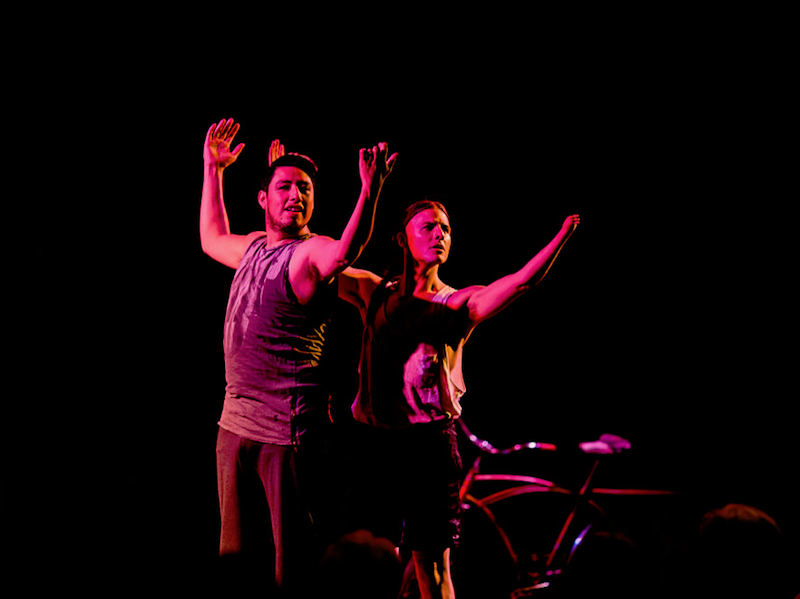Cripping the Arts

Justin Many Fingers (left) and Brian Solomon (right) during a performance of What's Left of Us. Photo: Michelle Peek Photography courtesy of Bodies in Translation: Activist Art, Technology & Access to Life, Re•Vision: The Centre for Art & Social Justice at the University of Guelph.
Can disability arts change how we understand and celebrate bodies and minds of difference?
In January, attendees gathered at the Harbourfront Centre in Toronto to explore this fundamental question throughout three days of panel discussions, co-creative workshops, exhibitions and performances as part of Cripping the Arts, an event held by the School of Disability Studies at Ryerson University, the British Council, Creative Users Project and Tangled Art + Disability.
“My hope for the conference was that it would bring about next-level conversations about disability arts,” says Eliza Chandler, an assistant professor in the School of Disability Studies and principal investigator on Cripping the Arts in Canada, a SSHRC Connection Grant which funded the second day of the symposium and related research activities.
“I wanted us to engage in sectoral conversations that reflect the fact that we’ve been making work for 40 years or more and that now is the time to engage in different kinds of discussions,” she continues.
Panel discussions featured disability artists, academics and activists who unpacked the ways in which Deaf, mad and disability arts disrupt typical understandings of difference, and, in turn, open up new possibilities for Canada’s art sector and, more broadly, for disability rights and justice.
For Chandler, one highlight included a discussion around the role of interdependence within disability arts, a sector that has a long and troubled history of leadership by non-disabled people.
“To fight against that paternalistic and ableist history, disability arts has really been asserting itself as needing to be disability-led,” she says. “We can now go back a little bit and complicate that notion.”
A panel on leadership included Michael Nimbly and Catherine Bourgeois from Joe Jack et John, a theatre collective based out of Montreal. “They really articulated how even though there is a non-intellectually disabled person who is writing the grants, drawing up budgets, writing the final reports — the artistic direction of that company is led by intellectually disabled folks,” she says.
“To understand that as accurately being disability-led requires us to challenge normative assumptions of what a leader looks like and what leadership roles look like.”
Another panel examined the — often problematic — representation of Deaf, disability and mad art in the media, and offered practical suggestions on how to increase the rigor of journalistic coverage.
Wheelchair dancer and performance art critic Shay Erlich (Child and Youth Care BA ‘14 MA ‘17) took part in in the discussion, alongside five other panelists. Erlich outlined their top three disability arts criticism pet peeves, one of which includes the ignorance of disability language and culture.
“It’s really crucial that we get people’s own understandings and representations of their identity in their exact words to be what appears in print. There needs to be absolute clarity that the terminology that people use to describe themselves is going to be the language that shows up in an article,” they explained.
The symposium itself featured innovative models of accessibility practices, which formed a particular point of pride for Chandler. “We really got to exercise our learning around accessibility in new kinds of ways,” she says.
In addition to taking place in a wheelchair accessible venue, the conference featured ASL interpretation, live captioning and transcription, a live drawer, a live audio describer, attendant care, an access team to help with accessibility needs, and a chill-out space on site.
“A key component to making things accessible is finding out what people need,” Chandler explains. In advance of the symposium, event organizers shared a survey with participants that outlined existing accessibility features and invited feedback on what else might be needed.
“Another component of making events accessible is letting people know how it will be accessible to them,” she continues. To that end, and with the support of a Faculty of Community Services internal seed grant, the organizing team put together an innovative and comprehensive Access Guide.
“The guide not only outlines accessible features but also lets people know what the venue looks like, how to get there, how to use accessible transit to get there, what to expect when you arrive,” she says.
Working in consultation with Sol Express, a creative and performance arts program for people labelled as having intellectual disabilities, the team explored how best to express words, language and concepts. The result? A plain language guide that includes photography of the venue, symbols to convey additional meaning, a question and answer format and a glossary of terms.
Eliza Chandler is co-director (with Carla Rice, Director of Re•Vision: the Centre for Art and Social Justice at the University of Guelph) of Bodies in Translation: Activist Art, Technology, and Access to Life (external link) , a $2.5 million SSHRC-funded Partnership Project.